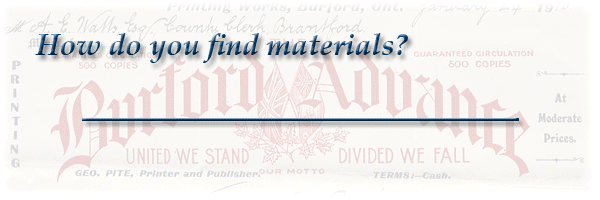
Archives are organized by the organizational body or person who created or accumulated the records. This is much different than in a library where materials are organized by subject. Libraries have materials that are about something. Archives have materials that are from someone.
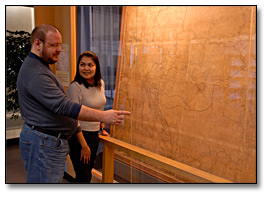
Two researchers viewing David Thompson's 'Great Map'
Photographed by the Archives of Ontario
In doing research in archives, you work from the perspective of the creator, entering into what that person observed, recorded and thought.
Records created by a single individual or a group is referred to as a fonds, pronounced as "pho" – without the "ds". The Archives of Ontario holds the T. Eaton Co fonds -- being textual records, photographs and audio-video created by the T Eaton Company Limited. It also has the David Thompson fonds comprised of notebooks, journals, field books and other material from David Thompson the mapmaker. The archivist studies the body of work of the records’ creator – noting relationships between records and changes over time.
The source of the fonds matters. This is the provenance or archival origins. In order to understand a group of records, their significance and value, the archivist must learn the origins, or the "Provenance" of the records: get to "know" the person, family, group or company that created, used and accumulated the records, and the circumstances in which they were created.
Archivists will try to preserve the original order used by the creator. Filing structure and organization can tell a lot about the individuals, relationships and events that created the materials.
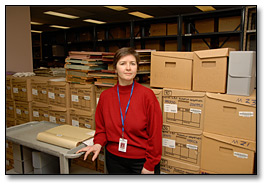
Archivist standing with newly received boxes
Photographed by the Archives of Ontario
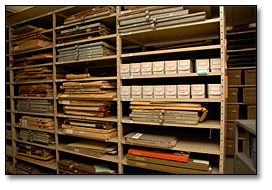
Archival Storage
Photographed by the Archives of Ontario
Together, the principles of provenance and of original order preserve the context of the records and contribute to a more complete understanding of the creator and situation.
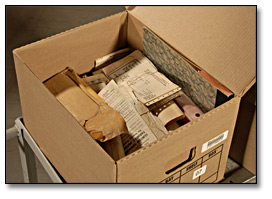
Box of unprocessed archival records
Photographed by the Archives of Ontario
In reality, however, few records arrive at the archives
nicely labelled and neatly filed. Archivists must attempt
to establish an order sensitive to the origins of the material,
but practical for researcher access.
Often it is not possible to physically maintain collections in the order they arrived . Many groups of records contain different types of media – paper records, film/video, photographic material or sound recordings – which have different storage and preservation requirements. In this instance, the original order is maintained on paper – carefully documented and described.
What tools are available?
Archivists have developed finding aids that describe the holdings and serve as guides.
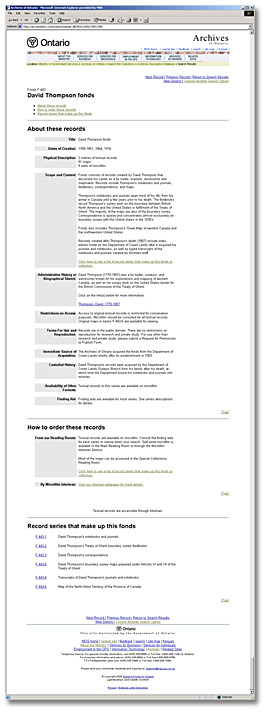
Further they try to describe items in a consistent way.
Archival descriptions divide groups of records into different
levels – fonds, (a group of records produced by a
single creator), series (record type or the purpose for
which they were created), and occasionally, individual items.
A description done according to Rules for Archival Description
will include a brief biography of the records creator, a
description of contents (including physical measurements)
and some relevant footnotes.
An archival description is designed to answer important questions about a group of records so that you can decide whether it relates to the topic that you are researching. These questions include:
- When was this material created?
Here you will find a date or range of dates that tell you when this group of materials was created.
- What type of material is it and how much of
it is there?
Here you will find information about the format and amount of material in this group of records. Does it contain maps, photographs, or sound recordings? If so, how many?
- How did this group of material come about and
what information does it contain?
Here you will find information about the personal or organizational activities that led to these records being created as well as information about the subject matter and content of the records.
- What person or group created the records?
Here you will find biographical information about the person who created the records or a history of the group that created the records. Knowing what a person did in their lifetime or what a group did in the conduct of its business can help to explain why these records exist and what they are about.
- Are there any restrictions on viewing, using
or copying these records?
Here you will find information about any restrictions that may affect whether you can view these records, have copies made or use them in a publication, broadcast or website. You may need to seek permission to use or publish records from a donor or copyright holder.
- How do I access this material?
There are a number of ways that archival records can be viewed. This part of the description may:
-
direct you to look at a detailed online or paper list to identify specific items that you wish to view
-
give instruction on how to order records to one of our reading rooms
-
direct you to contact an archivist or the Information and Privacy Unit of the archives for more information
link you to images in the Visual Database
-
direct you to our microfilm Interloan service which allows you to borrow microfilmed copies of records through your local library.
-
The Archives of Ontario describes government records based on function rather creator, because the creators - ministries, commissions, agencies and boards are constantly changing roles and responsibilities. All government record descriptions are tied to "agency histories" – brief sketches outlining responsibility changes over time.
For example, from 1869 to 1874 the Ontario. Dept. of the Commissioner of Agriculture and Public Works was responsible for immigration. To find information about immigration during that time period it would be necessary to search records based on function rather than by agency.
Descriptive tools at the Archives of Ontario
The Archives of Ontario maintains several databases.
- The online Archives Descriptive Database (ADD) provides information about many of the holdings and how to search for them. Use it to look up records and find out how much material is available, what the holdings include, and how to access the records.
- The Visual Database provides access to thousands of scanned images of photographs and documentary art held by the Archives of Ontario.
Customer Service and Research Guides have information on policies and procedures for using the Archives of Ontario, and offer further guidance on finding and using particular kinds of records.
Keep in mind, though, that not all holdings have been described yet. If you don’t find what you’re looking for, call, e-mail, or visit the Archives in person. Our reference staff will be happy to help you navigate our reading rooms and the resources you’ll find there.